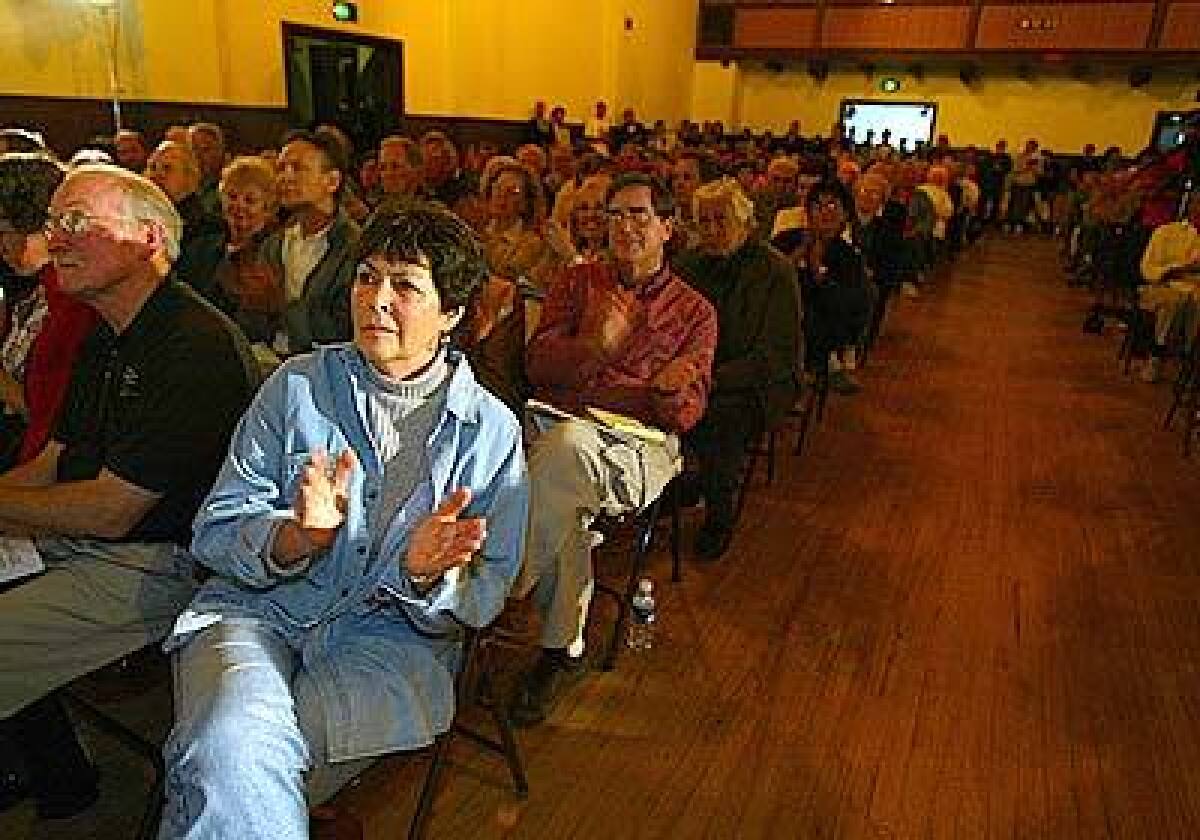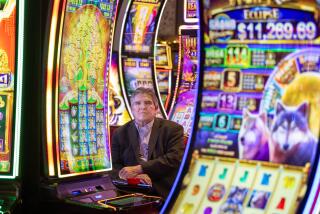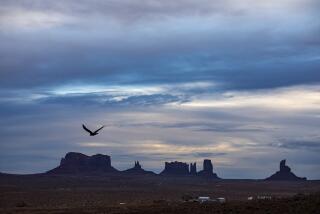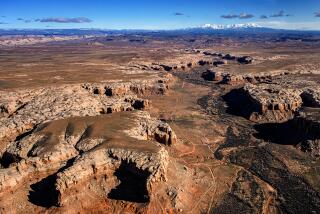Casino’s Success Breeds Tension

SANTA YNEZ, Calif. — In the 1960s, a group called Concerned Citizens held barbecue dinners, car washes and fashion shows to help bring indoor plumbing to the Chumash Indian reservation here.
The display of charity was not an isolated occurrence. Year after year, merchants donated toys and clothing to Indian children. Volunteers decorated the sparse tribal hall each Christmas and baked cookies for Chumash families.
“It was a very friendly atmosphere,” said Jody White, who strung pine cones and candy canes in the tribal hall.
Today, the Chumash inspire more fear than pity. A new Concerned Citizens group has emerged — not to help the tribe, but to fight its development plans. In a stunning reversal, the region’s wealthy landowners now view the Indians as a threat to their way of life.
The tribe’s casino resort, big enough to house two Costco Wholesale outlets, is the focus of much of the agitation. Residents complain that traffic is choking scenic highways, that noisy buses keep neighbors awake at all hours and that the glow of casino lights has obscured the stars in the night sky.
More worrisome, locals say, are the tribe’s plans for further development, which call for an opulent resort with several hundred luxury homes on a swath of open farmland near the reservation.
“People need to start figuring out that it ain’t the poor Indians anymore,” said Doug Herthel, an equine veterinarian in nearby Los Olivos. “This is a disaster.”
As Indian casinos have expanded across the state, many newly prosperous tribes have become embroiled in disputes with neighboring communities. Perhaps nowhere is the conflict as intense as in the Santa Ynez Valley.
The collision unfolding here is extraordinary in part because the Chumash, once impoverished and powerless, can now match the political and financial muscle of their adversaries — including ranchers, retired chief executives and Hollywood celebrities.
Accustomed to having their way, these property owners are confronting a sovereign entity flush with gambling revenue and unfettered by state or local land-use regulations. They are discovering, to their dismay, that there is little they can do to block the tribe’s ambitious development plans.
Despite raising more than $300,000 and hiring lawyers, lobbyists and consultants over the past year, residents can point to just one tangible achievement: delaying the issuance of liquor licenses for the casino resort.
Charles “C.J.” Jackson, a leading opponent of the tribe’s development proposals, says the struggle has been exasperating. If Home Depot wanted to build here, residents could fight the proposal before the zoning board, the county Planning Department and other agencies. They could lobby elected officials to intervene. They could file suit in local courts.
But none of those tactics works when the developer is a sovereign entity.
“If my objective was to just stop them,” Jackson said of the Chumash, “how effective have I been? They have essentially done what they wanted to do on their land.”
Slot Machines Added
Tensions began building in the valley after California voters approved a ballot initiative in 2000 that gave Indian tribes the exclusive right to offer Las Vegas-style gambling.The Chumash — formally the Santa Ynez Band of Mission Indians — first turned to gambling in 1983, offering high-stakes bingo in a tent. The operation faltered, closing and reopening several times. In 1994, the tribe added slot machines and began bringing in serious money — $31 million the first year.
The 2000 initiative legalized the slot machines, along with blackjack and other games of chance, and the Chumash reaped a windfall. The tribal casino, one of the most profitable in the state, is expected to generate $200 million in revenue this year.
The Chumash no longer have to rely on others for running water or clothing. In the last decade, the tribe has donated more than $6 million to charitable groups, schools, hospitals and fire and police departments.
Recently, the Chumash have begun building on a scale not seen before in the Santa Ynez Valley, a region of rolling canyons, boutique wineries and Danish-style motels and cottage inns.
The $157-million Chumash Casino Resort, which opened last year, is a far cry from the makeshift warehouse that once housed the gambling hall. The Mediterranean-style complex along Highway 246, by far the biggest building in the valley, features 2,000 slot machines, a concert hall, a 106-room hotel and two concrete parking structures.
Chumash officials said they took pains to mitigate the casino’s impact, reducing its height to three stories from the six originally planned, installing expensive low-glare outdoor lighting and providing $4.2 million in roadway improvements.
But these concessions did not ease residents’ worries that a powerful new force was reshaping the region. Their anxiety increased when word spread that the tribe intended to build beyond the reservation.
The Chumash plan to construct a museum, cultural center and retail complex on 6.9 acres near downtown Santa Ynez. It would be the first Chumash development on the north side of Highway 246, long the dividing line between the town and the reservation.
More controversial still is the tribe’s proposal to build a massive residential complex in partnership with actor-turned-developer Fess Parker, less than two miles east of the reservation.
Parker paid $6 million for 1,428 acres of farmland in 1998, but failed in his attempts to ease strict zoning laws, which allow no more than two houses for every 100 acres.
Then Parker approached the Chumash about selling approximately half of his property. Like other federally recognized tribes, the Santa Ynez band enjoys special land acquisition rights granted by the federal government in the 1930s to compensate for past seizures of Native American property.
Invoking those rights, the tribe hopes to annex the property to the reservation — after purchasing it from Parker. If the U.S. Bureau of Indian Affairs approves, the Chumash will be able to bypass county and state land-use regulations and build up to 500 luxury homes, a resort hotel and a championship golf course.
The proposal has bared deep resentment on both sides. In a full-page advertisement in a local newspaper, British songwriter Bernie Taupin denounced the Parker-Chumash partnership as “a treaty designed to line their pockets and damn the land.”
Taupin, 54, who wrote the lyrics for many of singer Elton John’s hits, has owned a ranch in the Santa Ynez area since 1992.
“Should this atrocity go ahead, it would surely be the beginning of the end for this pastoral wonderland we cherish,” he wrote. “The fight has only just begun. I can guarantee we will snap at Mr. Parker’s lanky heels till his skin is raw.”
The letter was signed by a number of prominent valley residents, including actress Bo Derek, singer David Crosby and his wife, Jan, and bandleader Doc Severinsen.
The Chumash took offense at what they saw as the critics’ proprietary attitude toward the hills and pastures of the valley.
“We’ve been here a lot longer than any of the complainers,” said tribal chairman Vincent Armenta, 41, whose grandparents raised 10 children in a lean-to on the reservation.
Referring to Taupin, he asked: “Where does a foreigner get the gall to tell the first Americans what we can do with our own land?”
Frozen in Time
The Santa Ynez Valley, about a three-hour drive north of downtown Los Angeles, is carpeted with oak trees. Cattle graze on open range land, and hawks circle overhead. The area provided a scenic backdrop for the movie “Sideways,” and Michael Jackson’s Neverland Ranch is here.In central Santa Ynez (pop. 4,584), a two-block stretch of Western-style storefronts feels frozen in time. Residents pull up on horseback to chat with neighbors. At a corner service station, attendants in crisp blue uniforms clean windshields and check under hoods. The one-room public library, established in 1912, is open on Saturdays only from 2 to 5 p.m.
The valley’s population has grown steadily, to more than 20,000, as urban dwellers discovered the scenic beauty and laid-back lifestyle, but the area remains nearly 90% white.
For decades, relations between the Chumash and their neighbors were cool but quiet.
Jose Escobedo, who has lived across Highway 246 from the reservation since 1973, said that except for the occasional beating of drums in the distance, he and his family were barely aware of the Indians’ presence.
“You could drive by the reservation and not pay attention to it,” said Escobedo, now director of human resources at the casino.
That changed, slowly at first, as the tribe turned to gambling as an antidote to chronic poverty. When the bingo parlor opened in 1983, the Chumash invited residents to tour the modest tent facility.
“We were delighted,” said Jody White, who has lived in Santa Ynez for 24 years. “They were going to do something to bring them income.”
Not everyone was so enthusiastic. Some business leaders demanded that the tribe remove the town’s name from the neon casino sign.
When slot machines and, later, full-scale Vegas-style gambling brought the Chumash undreamed-of prosperity, residents began to view the Indians differently, said Michael Lombardi, the casino’s first general manager.
“I saw the community’s attitude change from one of contempt to respect to jealousy,” Lombardi said. “The feeling was, it’s OK for them to be successful. Just don’t be too successful.”
Lammy Johnstone-Kockler, who moved to the Santa Ynez area 11 years ago, said she too has seen attitudes change, and not for the better.
Some of her acquaintances stopped visiting her home after seeing tribal members there in recent years, said Johnstone-Kockler, a retired publishing executive. She said she has seen patrons in local restaurants flash unwelcoming looks at Chumash Indians.
“I know people who have homes up for sale because some of them are convinced the Chumash are going to buy up the entire Santa Ynez Valley,” she said.
Chumash members say they have felt increasing hostility as they acquired new homes, luxury cars and other trappings of wealth. Each of the 153 enrolled members of the Santa Ynez band — those with at least one-fourth Chumash blood — has collected more than $1 million in casino proceeds in the last four years.
Adelina Alva-Padilla is the tribe’s medicine woman and spiritual leader.
“People used to talk to me in town,” Alva-Padilla said. “Now they just look at me and turn. I can see the hate people have for us . They think we’re so darned greedy.”
Julio Carrillo, another tribe member, says valley residents have come full circle, from feeling sorry for the Chumash to resenting them. “We’re the new dog on the block,” he said. “And they need to get used to it.”
Valley’s Transformation
C.J. Jackson says he first noticed the casino’s impact on a weekday in 1999, four years after moving to the area. He was driving to meet his children at soccer practice.The casino was holding a drawing for a new car. Traffic backed up in both directions on Highway 246. Jackson says he saw locals speed through residential streets to avoid the congestion.
“I watched a couple of cars come around a curve awful fast as kids were walking to soccer practice,” said Jackson, 46, who lives a quarter of a mile from the reservation. “That’s why I got activated.”
Jackson is the unpaid executive director of Santa Ynez Valley Concerned Citizens, a nonprofit group devoted to preserving the area’s rural landscape. Like most residents in the valley, Jackson says, he supported the 2000 ballot initiative on Indian gambling.
“I think everybody recognizes it is better than having poverty over there,” he said. “The problem is nobody quite expected the Chumash would exploit it the way they have.”
Jackson complains that the Chumash, as a sovereign entity, do not have to obey zoning laws, publicize their plans or hold extensive public hearings, as other developers do.
Chumash leaders say they have merely exercised their rights under federal and state laws to expand their casino operations. Development on reservation land is subject to scrutiny by federal agencies — such as the Interior Department and the Environmental Protection Agency — but not to the detailed rules and elaborate procedures of local land-use agencies.
Chumash supporters suggest that Jackson has a personal motive for opposing the tribe’s development projects. Since 1943, his family has operated the Alisal Resort in Solvang, a 10,000-acre cattle ranch with two golf courses, equestrian trails and a 100-acre lake.
“The leadership of the opposition has an economic stake in stirring the pot,” said Parker, 80, who has lived in the valley for 17 years.
Cast in the new role of underdogs, Jackson and other opponents have waged a kind of guerrilla war on the tribe’s development plans. If they could not block the casino expansion, they could complicate and delay it.
So residents fought sewer agreements that the tribe negotiated with local municipalities to treat casino wastewater. They protested a $60,000 annual contract between the Chumash and the local high school to handle overflow casino parking.
And they deluged state authorities with letters and appeals opposing the tribe’s request to serve alcohol in the casino’s gourmet restaurant and put tiny liquor bottles in hotel-room mini-bars.
The fight against the liquor permits was led by Curtis Moniot, a home designer who moved to Santa Ynez in 1993 and is president of the Concerned Citizens coalition.
“If a drunk driver from the casino hits my wife and family on the highway, I can’t sue the tribe,” said Moniot, 48. “I’m not opposed to the tribe having a license . All I want is to make sure that, if they get a license, it is under the same terms and conditions as anyone else.”
Chumash leaders took special offense at the effort to deny them liquor licenses. They say their liquor license is identical to any other issued by the state. They point to a provision in the California business code that prohibits sellers of alcohol from being held civilly liable.
They also question why the community has not expressed concern about the dozens of wineries and restaurants that serve liquor in the valley.
Before applying for the liquor licenses, the tribe agreed to numerous restrictions, including prohibiting alcohol on the casino floor.
Chumash leaders reacted strongly when an unsigned letter was circulated in Santa Ynez warning about “the added risk of our family and friends being killed or maimed from intoxicated persons” if the tribe received liquor licenses.
In a commentary published in a local newspaper, Armenta asserted that the anonymous message was from “an anti-Chumash hate group” and fell “into the category of a hate crime.”
Because of the opposition, it took the tribe 15 months to secure a liquor permit for the casino restaurant — nine months longer than normal. The request for a liquor permit for the hotel mini-bars, filed in March, is pending.
Community leaders scoff at the notion that their opposition is racially biased. They say they would use the same tactics to resist large-scale development in their backyard by the Walt Disney Co.
“We are not an anti-Indian group,” said Jackson. “What we have in common is a simple belief that everyone should play by the same fair rules.”
Chumash leaders see something else at work — an entrenched belief that Indians are second-class citizens. “The implication is that we don’t know what we’re doing,” said Armenta, “and we belong on the side of the road selling blankets to tourists.”
The Chumash point to assertions that the casino resort would become a magnet for crime, including prostitution. “We could have the best little whorehouse in Santa Ynez right here,” one resident said during a 2002 public hearing on the project.
The Santa Barbara County Sheriff’s Department says it has no record of prostitution arrests at the casino. Minor offenses such as public drunkenness and petty theft have more than tripled since 2000 with the expansion of the casino, but authorities say there has been no significant increase in major crimes.
Tensions flared anew last spring, when Gail Marshall, the county supervisor representing Santa Ynez, was quoted in a book as saying that Chumash “are not real sophisticated people.”
“They don’t want to be educated. You know, they’ve all got brand new trucks and lots of money,” Marshall told a UC Santa Barbara law instructor. “They’re thumbing their nose at everybody.”
The Chumash demanded that the board of supervisors repudiate Marshall’s statements and called for her resignation. Scores of tribal members crowded into a supervisors’ meeting in March to condemn Marshall’s “racist” remarks.
When tribal member Reggie Pagaling began addressing the supervisors in the Chumash language, a man wearing boots and a cowboy hat interrupted him.
“This is America, pal,” the man said. “Speak English!”
Invoking Sovereignty
Chumash leaders have at times added to the friction by invoking their sovereign authority over minor matters.When the tribe got into a billing dispute with a local contractor, members passed an ordinance prohibiting him from setting foot on the reservation.
In another case, the Chumash issued a “cease and desist” order to the nearby Santa Ynez Airport, demanding that planes stop flying over the reservation. Tribal attorneys threatened to sue Santa Barbara County if the airport continued to violate the tribe’s airspace.
The tribe dropped the issue. “We could have shut down the airport,” Armenta said. “But that was not our intent. The letter was to let them know they are not supposed to be doing it.”
For years, Chumash leaders have insisted that the opposition was confined to a handful of overzealous critics. That was before April 7.
On that evening, the Concerned Citizens coalition organized a town meeting to discuss the tribe’s proposed project with Parker.
About 800 people — ranchers, teachers, bankers, artists, retirees and celebrities such as Derek and TV gossip maven Rona Barrett — filled the Veterans Memorial Hall in Solvang to overflowing. A fire marshal removed about 100 people who had blocked aisles and exits.
On the stage was an artist’s rendering of the $250-million Morongo casino near Cabazon. It showed a 27-story casino resort piercing the sky, with an ominous warning: “It could happen here.”
“We always said it was a handful of people who opposed us,” said Frances Snyder, a tribal member and spokeswoman for the Chumash. “When you see the so-called concerned citizens using scare tactics to attract nearly a thousand people, it is worrisome.”
Residents have called for a boycott of Parker’s bed-and-breakfast in Los Olivos and urged diners to avoid restaurants that carry Parker’s wines. They have slapped “FESS” stickers on stop signs.
“There are some people who will never, ever be able to relax or be pleasant,” Parker said.
His ongoing talks with Chumash leaders about the proposed development are “up in the air,” Parker said, pending a tribal election in March.
“It has been mentioned that perhaps they would like to proceed with their own ideas,” Parker said. “I’ve informed them that while they are trying to make up their mind, I am pursuing other avenues.”
Parker added that he is willing to consider building a smaller-scale development that would follow local and county land-use ordinances.
The tribe took back its $250,000 deposit on the development site when negotiations with Parker failed to produce a purchase agreement by a July deadline. But Armenta says negotiations are continuing, and he is confident the tribe will once again prevail over its adversaries.
“At what point in time,” he said, “are they going to get tired of losing?”
Times staff researchers Maloy Moore and Penny Love contributed to this report.
Glenn F. Bunting can be reached at glenn.bunting@latimes.com.
*
About this report
This is the last in a series of occasional stories on the impact of casino gambling at the Chumash reservation in Santa Barbara County. To see previous stories and a video report, go to latimes.com/chumash.
More to Read
Start your day right
Sign up for Essential California for news, features and recommendations from the L.A. Times and beyond in your inbox six days a week.
You may occasionally receive promotional content from the Los Angeles Times.






